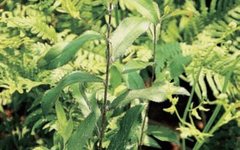Traditional Chinese Medicine (TCM) is a unique health resource in our country, a potentially vast economic resource, a technology resource with original advantages, an excellent cultural resource, and an important ecological resource. Since the time of Shennong tasting hundreds of herbs, a wealth of clinical experience has been accumulated over thousands of years, making a significant contribution to the survival and health of the Chinese nation.
Cangzhu (Atractylodes Rhizoma)
ATRACTYLODES RHIZOMA
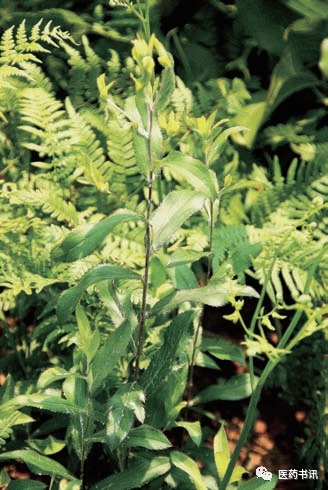
【Alias】 Chi Zhu, Zhu Sha Dian Cangzhu, Qiang Tou Cai, Shan Ci Cai【Source】 The dried rhizome of the Compositae plant Atractylodes lancea (Thunb.) DC. or Atractylodes chinensis (DC.) Koidz.【Herbal Examination】 This product was first recorded in the Shennong Bencao Jing. The Bencao Gangmu states: “Cangzhu is dry in nature, so it is soaked in glutinous rice water to remove its oil, sliced, and dried for use. It can also be stir-fried with sesame oil to reduce its dryness.” The Shennong Bencao Jing Shu states: “For diseases belonging to Yin deficiency with little blood, insufficient essence, internal heat with bone steaming, dry mouth and lips, cough with phlegm, hemoptysis, epistaxis, throat obstruction, and constipation, it is contraindicated. Those with liver and kidney Qi stagnation should not take it.” The Pujifang records Cangzhu powder, stating: “For treating wind swelling of the gums: take large Cangzhu, cut into two pieces, make a hole in the middle, fill it with salt, wrap it in wet paper, burn until charred, take out and grind finely, and use this to wipe it, removing wind and saliva, thus curing it. Rinse the mouth with salt water.” The herbal records are consistent with the Cangzhu used today.【Original Plant】1. Atractylodes lancea is a perennial herb, growing 30 to 80cm tall. The rhizome is large and irregular. The stem is single, round with longitudinal ridges, and slightly branched at the top. The leaves are alternate, leathery, and thick; the lower leaves are mostly 3-lobed, with pointed lobes, the largest lobe being ovate at the base, clasping the stem slightly; the upper leaves are ovate-lanceolate to elliptical, without petioles, and have spiny margins. The upper surface is dark green, while the underside is slightly white-powdered. The head-shaped flower clusters are terminal, about 2cm in diameter; the involucre is leaf-like with many spiny lobes at the base; the involucral bracts are 6 to 8 layers, lanceolate; the flower receptacle is flat, with many flowers, both bisexual and unisexual, often on different plants; the bisexual flowers have many feathery long crown hairs; the corolla is tubular, white, sometimes slightly reddish-purple, with 5 lobes, the lobes being linear; the stamens are separate; the ovary is inferior, elongated, densely covered with white soft hairs, the style is long, and the stigma is 2-lobed. The unisexual flowers are generally female, with 5 degenerated stamens, completely separate, slightly curled at the tips, while the rest is the same as the bisexual flowers. The achene is elongated, about 5mm long, covered with brownish-yellow soft hairs. The flowering period is from 8 to 10 months, and the fruiting period is from 9 to 10 months. It grows in drier places on hillsides, distributed in Jiangsu, Zhejiang, Anhui, Jiangxi, Hubei, Hebei, Shandong, and other regions.
Atractylodes lancea (Photo by Yan Hui)
(Image: New Compilation of Chinese Medicinal Materials, China Medical Science and Technology Press)▼
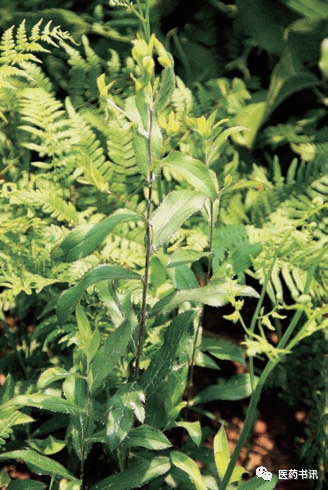
2. Atractylodes chinensis differs from Atractylodes lancea in that its rhizome is thick and tuberous. The lower leaves are spoon-shaped, mostly 3 to 5 deeply lobed, with blunt tips, and the base is wedge-shaped, slightly clasping the stem; the upper leaves are ovate-lanceolate to elliptical. The flowering period is from 7 to 8 months, and the fruiting period is from 8 to 10 months.
Atractylodes chinensis
(Image: New Compilation of Chinese Medicinal Materials, China Medical Science and Technology Press)▼
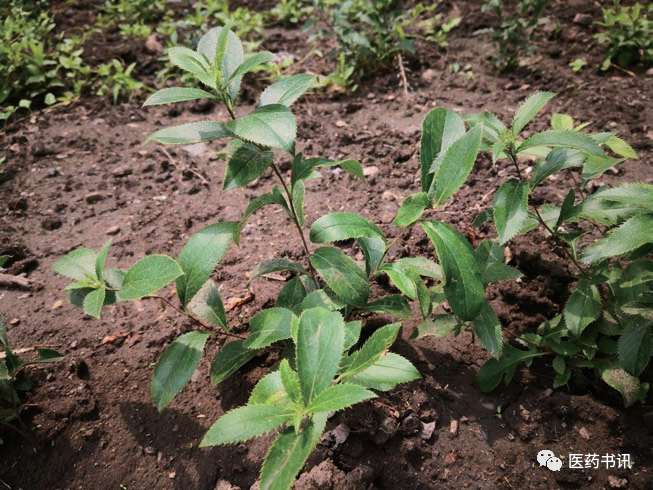
It grows in wild grassy slopes, under forests, in shrubs, and in rock crevices. It is distributed in Heilongjiang, Liaoning, Jilin, Inner Mongolia, Hebei, Shanxi, Gansu, Shaanxi, Henan, Jiangsu, Zhejiang, Jiangxi, Anhui, Sichuan, Hunan, Hubei, and other regions. It is widely cultivated in medicinal gardens across various regions. It is also found in North Korea and the Far East of the Soviet Union.【Main Production Areas】1. Atractylodes lancea is mainly produced in Jiangsu, Hubei, and Henan. Additionally, Zhejiang, Anhui, and Jiangxi also produce it.2. Atractylodes chinensis is mainly produced in Inner Mongolia, Hebei, Shanxi, Liaoning, Jilin, and Heilongjiang. Additionally, Shandong, Shaanxi, and Gansu also produce it.【Cultivation Key Points】1. Biological Characteristics: Prefers cool climates, drought-resistant, and avoids waterlogging. It is best cultivated in semi-shaded, deep, loose, fertile, humus-rich, well-drained sandy loam.2. Cultivation Techniques: Propagated by seeds or rhizomes. Seed propagation: direct seeding or seedling transplanting. Direct seeding is done in early spring; seedling transplanting is similar to direct seeding, and can be transplanted after 1 to 2 years of cultivation. Rhizome propagation: during harvest, cut off the rhizome with buds, and plant immediately, covering the soil firmly.3. Pests and Diseases: Diseases: root rot. Pests: aphids, grubs.【Harvesting and Processing】 Harvest in spring and autumn, remove residual stems and fibrous roots, wash off the soil, dry, and slice for storage. Can be used raw or stir-fried.【Product Specifications】 All are standard goods. Atractylodes lancea: dried goods, with a diameter of 0.8cm or more in the middle. No fibrous roots, impurities, insect damage, or mold. Atractylodes chinensis: dried goods, with a diameter of 1cm or more in the middle. No fibrous roots, impurities, insect damage, or mold.【Herb Identification】(1) Physical Characteristics1. Atractylodes lancea is irregularly bead-like or tuberous cylindrical, slightly curved, occasionally branched, 3 to 10cm long, and 1 to 2cm in diameter. The surface is gray-brown, with wrinkles, transverse grooves, and residual fibrous roots, with the top having stem scars or residual stem bases. The texture is solid, and the cross-section is yellow-white or gray-white, scattered with many orange-yellow or brown-red oil chambers, which can produce white needle-like crystals when exposed for a while.
Atractylodes lancea Herb Image
(Image: New Compilation of Chinese Medicinal Materials, China Medical Science and Technology Press)▼
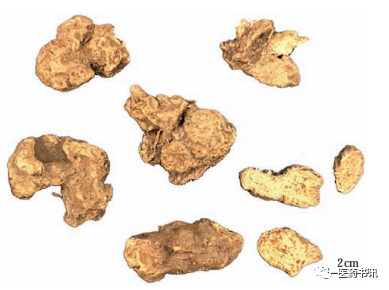
2. Atractylodes chinensis is in a lump-like or tuberous cylindrical shape, 4 to 9cm long, and 1 to 4cm in diameter. The surface is black-brown, turning yellow-brown when the outer skin is removed. The texture is relatively loose, and the cross-section has yellow-brown oil chambers. The aroma is relatively faint, with a spicy and bitter taste. It is in a lump-like or tuberous cylindrical shape, 4 to 9cm long, and 1 to 4cm in diameter. The surface is black-brown, turning yellow-brown when the outer skin is removed. The texture is relatively loose, and the cross-section has yellow-brown oil chambers.
Atractylodes chinensis Herb Image
(Image: New Compilation of Chinese Medicinal Materials, China Medical Science and Technology Press)▼
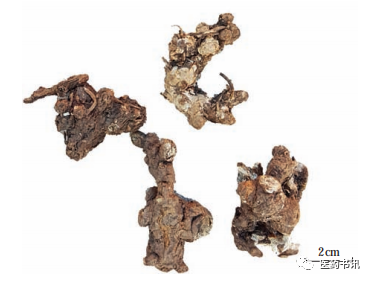
(2) Microscopic Identification
1. Cross-section of the root shows several rows of cork cells, with stone cell rings, broad cortex, scattered large oil chambers; the phloem is narrow; the cambium is not obvious; the xylem contains xylem fiber bundles; the rays are wide, with a central pith; the parenchyma cells contain inulin and scattered small calcium oxalate needle crystals.
2. Powder Characteristics The powder is brown. Calcium oxalate needle crystals are small, 5 to 30μm long, irregularly filling the parenchyma cells. Fibers are mostly in bundles, elongated, with a diameter of about 40μm, with very thick walls, lignified. There are many stone cells, sometimes connected with cork cells, polygonal, round, or rectangular, with a diameter of 20 to 80μm, with very thick walls. Inulin is often seen, with a radial texture on the surface.
(3) Physicochemical Identification
Thin Layer Chromatography Take the powdered product, treat with n-hexane ultrasonically, filter, and take the filtrate as the test solution. Take Cangzhu reference material 0.5g, and prepare the reference material solution in the same way. For thin-layer chromatography testing, take 2μl of the test solution and 4μl of the reference material solution, and spot them on the same silica gel G thin-layer plate, using petroleum ether-ethyl acetate (20:1) as the developing agent, develop, take out, and dry. Spray with 5% dimethylaminobenzaldehyde in 10% ethanol sulfuric acid solution, and heat until the spots are clearly colored. In the test solution, at the corresponding position of the reference material solution, the same colored spots appear.
【Quality Evaluation】Those with solid texture, many red spots on the cross-section, and strong aroma are preferred. Using high-performance liquid chromatography, the content of Cangzhuoside (C13H10O) in the dried product should not be less than 0.30%.【Chemical Composition】The main chemical components of Cangzhu include terpenoid volatile oils, aliphatic volatile oils, aromatic volatile oils, and glycosides.1. Terpenoid Volatile Oils Cangzhu ketone, 3β-hydroxy Cangzhu ketone, caryophyllene ketone, Cangzhu lactone I to III, wood aromatic lactone, long-leaf pine terpenes, caryophyllene, β-eucalyptol, β-eucalyptol, etc. Among them, Cangzhu ketone, caryophyllene ketone, and Cangzhu lactone I are the main active components.2. Aliphatic Volatile Oils Butanoic acid 4-hexyl ester, long-leaf pine terpenes, L-ascorbic acid-2,6-dipalmitate, 1-methyl-2,4-bis(l-methylvinyl)-cyclohexane, 2,4-dimethyl-2-pentene, (Z)-pentanoic acid-2-pentene-1-ester, and 3-icosanone, etc.3. Aromatic Volatile Oils Trans-zerumbone, hexamethyl-1,3,5-triazine, 2-butyl methoxy-1,1,10-trimethyl-6,9-dihydronaphthalene, and 6-vinyl-4,5,6,7-tetrahydro-3,6-methyl-5-isopropenyl- (S)-coumarin, etc.4. Other Volatile Oils tert-pentanoic acid-3,5-fluoropromazine-6-methoxy-cholesterol-22-ene-21-ol, isopropyl ketone, and 3β-acetoxy-5-cholamide, etc.5. Glycosides Cangzhu lactone A, epimedium glycoside F2, epimedium glycoside D1, inulin, Cangzhuoside, Cangzhuoside B, β-sitosterol, vanillic acid, and carotenoid glycosides, etc.【Nature and Flavor】Spicy, bitter, warm. Enters the spleen, stomach, and liver meridians.【Functions and Indications】Dries dampness and strengthens the spleen, dispels wind and disperses cold, brightens the eyes. Used for damp obstruction in the middle jiao, abdominal distension, diarrhea, edema, beriberi, rheumatic pain, wind-cold common cold, night blindness, and blurred vision.【Pharmacological Effects】1. Effects on the Digestive System Cangzhu has protective effects on the intestines and promotes intestinal movement; its anti-inflammatory properties are the mechanism for its anti-diarrheal effects. The butanol extract of Cangzhu has a broad-spectrum anti-ulcer effect and can inhibit protease activity and gastric acid secretion, while the water decoction of Cangzhu is effective against ulcers caused by excessive gastric acid secretion and mucosal lesions due to histamine.2. Blood Sugar Lowering Effects Cangzhu polysaccharides A, B, and C have a dose-dependent effect on lowering blood sugar levels in normal mice. Cangzhu polysaccharide A can lower blood sugar levels in alloxan-induced hyperglycemic model mice. Additionally, Cangzhu extract can inhibit small intestinal sucrase from hydrolyzing sucrose, which can be used to reduce glucose absorption in diabetic patients.3. Antibacterial and Anti-inflammatory Effects The volatile oils in Cangzhu have significant anti-inflammatory effects, which are related to the inhibition of PGE2 production in tissues. When stored at room temperature, the anti-inflammatory effects of Cangzhu volatile oils increase with prolonged storage time. Cangzhu has varying degrees of inhibitory effects on 15 types of fungi.4. Antitumor Activity The alcohol extract of Cangzhu has tumor-suppressing effects on hamsters with cholangiocarcinoma. The methanol extract of Cangzhu has anti-skin cancer activity; the ethanol extract of Atractylodes chinensis has cytotoxicity against human cholangiocarcinoma cells, and also has anti-angiogenesis and anti-cell invasion effects.【Notes】1. Cangzhu is also edible and is used as a health food in Japan, South Korea, and Singapore. Edible method: young shoots in early spring are blanched in boiling water and then soaked in clean water to remove the bitterness, after which they can be stir-fried, dipped in sauce, pickled, or made into soup.2. Atractylodes japonica Koidz. ex Kitam. is also a common medicinal material mainly produced in Northeast China, different from Atractylodes lancea or Atractylodes chinensis. Atractylodes japonica is mostly exported to Japan and is rarely used domestically.The above excerpt is from New Compilation of Chinese Medicinal MaterialsFor more knowledge about medicinal materials, please follow [Medical Book News]Daily one medicinal material from seven regions: Northeast, North China, Northwest, East China, Central China, South China, SouthwestScan the QR code to purchase this book
Previous Reviews
1. Keeping People Healthy
2.Ear, Acupuncture for Over Two Thousand Years
3.Coronary Heart Disease Effective Secret Recipe | Blood Activating and Stasis Removing Decoction
4.Famous Doctors Discuss Diseases with You
5.Big Data Anatomy | Skull
6.Why Are the Eyes of Masks So Big?
7.Three Minutes to Understand | Microneedle Therapy for Stiff Neck
8.Scholar Studies Medicine, Catches Chickens in a Cage
9.Medicine Does Not Last Three Generations, Do Not Take Its Medicine.
10.Huang Bo Talks About Medicine | An Interesting Method for Fetal Testing


To purchase this book, please click on the link below to read the original text

